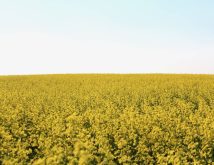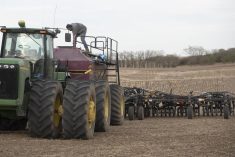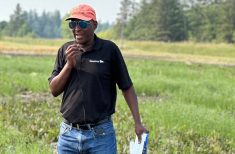Manitoba farmers say they are open to trying new 4R techniques and building upon current practices but have an eye on cost and risks.
It’s important to be challenged by the question, “what more can we do to reduce our emissions… while running a farm properly?” said Dean Harder, who farms near Morris.
During this summer’s consultations on federal nitrogen emissions reduction goals, multiple farm groups asked the government to empower farmers to manage nutrients through the 4R nutrient stewardship framework.
Read Also

Mandatory holiday joy a valid struggle
Christmas may not be that jolly for everyone. Farm family coach Kalynn Spain suggests those struggling with over-the-top joy during the holidays instead aim for “fulfilled” or “content.”
The federal government launched the On Farm Climate Action Fund (OFCAF), which provides funds to farmers to offset costs of new management practices, including 4R nitrogen management. In Manitoba, the Manitoba Association of Watersheds and the Canola Council of Canada administer those programs.
[RELATED] Editor’s Take: There’s money on the table. Use it
A little over half of canola and spring wheat acres in Western Canada are managed using basic 4R, according to 2021 Fertilizer Canada data. That means those producers have gone through a process to have those acres recognized as managed with 4R.
The government is keen to increase verified acres, said Curtis Rempel, vice-president of crop production and innovation with the Canola Council of Canada.
But what does that look like on the farm?
On the farm
Farmers who spoke with the Manitoba Co-operator said most are already using 4R principles to some degree, even if not formally recognized.
“That’s simply based on economics,” said Clayton Harder, who farms north and east of Winnipeg. “Nitrogen has never been free or cheap.”
Harder said he has about a third of his fields soil-sampled annually, enough to get a representative sample of the whole farm. He applies anhydrous ammonia at seeding, and if he broadcasts nitrogen, it’s immediately incorporated.
Harder said he’s tried a number of enhanced-efficiency products, including a nitrification inhibitor with anhydrous ammonia, but they didn’t provide any yield benefit.
Nicolea Dow said she is working to get her farm’s 4R designation, but has been following its principles for a while. On their farm, east of Portage la Prairie, they soil test all fields annually, apply nitrogen at seeding and have often used ESN (environmentally smart nitrogen) to reduce losses.
Dow said they apply ESN in conditions where they’re more concerned about loss, for example when putting down heavy loads of nitrogen at once. Because of ESN’s slow release, it spreads the risk of loss over the season, Dow said.
[RELATED] ESN off the table for climate fund incentives
Jake Ayre said his family soil tests annually and has done so for about 20 years. On their farm, near Minto, they’ve done electrical conductivity mapping on some fields. Combined with soil tests, it allows them to use precise, variable-rate nitrogen application.
Ayre said this has saved him a significant amount of fertilizer over the past three years. He hasn’t tried enhanced-efficiency fertilizer but plans to do so.
Dean Harder said he does “little trials” each year on his farm – trying ‘eco tea,’ cover crops and different crop varieties that might reduce fertilizer use. They’ve spread manure on their fields and seen a benefit both as a fertilizer and in building the soil, he said.
Harder, who farmers near Morris, has plans to try a nitrification inhibitor in anhydrous ammonia because he’s seen research suggesting it will significantly reduce emissions.
His family recently replaced the air seeder with a disk drill, which Harder said will help with 4R and conserve moisture in dry years.

Pros and cons
Most farmers the Co-operator spoke with had applied for OFCAF funds or were interested in doing so.
Ayre said he applied for funds to EC map more fields for variable rate application and Harder was interested in expanding soil testing. Dow said she was looking into products to reduce nitrification.
“There is some money on the table for things like that. It makes it a lot more attractive to look at,” she said.
Most saw funding as an obstacle to more advanced 4R management.
Dow said enhanced efficiency fertilizer is a great tool but it is expensive. It reduces nutrient loss and thus financial loss in some years but in other years makes no difference.
“If the government wants that, they need to put some money where their mouth is,” Dow said, adding it was good to see money for enhanced efficiency fertilizer under OFCAF.
“We are trying our best, but a lot of these things come at a cost,” said Pam Bailey, who farms near Dacotah, adding that farmers can’t pass the extra cost to consumers.
“We’re always trying to get better,” she said. “There’s always ways to improve.”
Harder said he is willing to try new things but not every experiment pays off. Cover crops did not work well for him, though he’d be willing to try again.
He also suggested more agronomists would aid in emissions reduction efforts, citing the National Farmers Union that advocates for a “Farm Resilience Administration” that would have thousands of independent extension staff.
Some farmers hadn’t found time to fill out OFCAF paperwork or were concerned that the programs were full. The Canola Council of Canada said it is still accepting applications for funding.
The degrees of 4R
A designation of basic 4R indicates the farm’s practices are “generally consistent with 4R principles.”
On the Prairies, that may involve fall nitrogen application only after the soil cools, or in spring; setting crop and field-specific nitrogen rates using soil tests or other methods; subsurface banding or broadcasting and incorporating.
Intermediate 4R practices include use of enhanced efficiency fertilizers; application based on quantitative estimates of in-field variability; and annual soil tests to determine application rates, on top of basic practices.
Advanced practices add advanced variable rate application, e.g. digitized prescriptions; increased data collection through crop sensors, scouting and aerial imagery; in-season application; and elimination of fall nitrogen broadcasting.
















